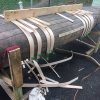The Old Town canoe with serial number 156804 is shown as 16 feet long, CS (common sense or standard) grade, a Yankee model with western red cedar planking amd open spruce gunwales. The canoe was built between December 1951 and June 1952. The original exterior paint was dark green. It was shipped to Amesbury, Massachusetts on June 25, 1952. A scan of this build record can be found by following the link behind the thumbnail images attached below.

This scan and several hundred thousand others were created with substantial grants from the Wooden Canoe Heritage Association (WCHA) and others. A description of the project to preserve these records is available at
http://www.wcha.org/ot_records/ if you want more details. I hope that you will join or renew your membership to the WCHA so that services like this can continue. See
http://www.wcha.org/about-the-wcha/ to learn more about the WCHA and
http://store.wcha.org/WCHA-New-Membership.html to join.
It is also possible that you could have another number or manufacturer if this description doesn't match your canoe.
I can't speak to whether you were lucky or not -- depends on the condition of the canoe, the price, and whether anyone else was interested right then in a canoe in that area. Perhaps someone else is familiar with the craigslist ad and/or the canoe and will comment.
But we all would enjoy seeing pictures of the canoe.
And welcome to the WCHA. If you have any questions about restoring your new (for you) canoe, don't be bashful about asking here.
Further, whether you plan to do it yourself or to hire a professional, there are three good sources of information that you would do well to get, or at least look at, before making any decision about how to proceed when considering any work on a wood/canvas canoe -- maintenance, repair, restoration (if you have not already seen at least one of them):
The Wood and Canvas Canoe: A Complete Guide to its History, Construction, Restoration, and Maintenance by Rollin Thurlow and Jerry Stelmok
Building the Maine Guide Canoe by Jerry Stelmok
This Old Canoe: How To Restore Your Wood-Canvas Canoe, by Mike Elliott
The first is often called the "bible" of canoe repair, restoration, and maintenance; the second is an excellent study of the wooden/canvas canoe and its construction. The third was just recently published and has gotten some good reviews.
Of course, you can always ask questions here on the forums -- don't be shy, even if your question seems simple. We have all faced situations where we weren't sure what to do, but others have faced the same situations and figured out how to proceed.
You might also want to look at The Old Town Canoe Company by Susan Audette and David Baker, a great history of the Old Town company and its canoes.
These books are all available from the WCHA store, and are often on eBay, or available from Amazon and other book retailers.
Feel free to reply here if you have any other questions.
Greg
WCHA President























